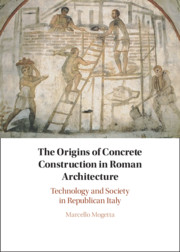 The Origins of Concrete Construction in Roman Architecture
The Origins of Concrete Construction in Roman Architecture Book contents
- The Origins of Concrete Construction in Roman Architecture
- The Origins of Concrete Construction in Roman Architecture
- Copyright page
- Contents
- Plates
- Figures
- Tables
- Acknowledgments
- One Introduction
- Two Deconstructing Roman Concrete
- Three A New Date for Concrete in Rome
- Four A View from the Suburbium
- Five Building Samnite Pompeii
- Six Colonial Networks
- Seven Conclusion
- Appendix Catalog of Sites
- Glossary
- Bibliography and Abbreviations
- Index
- Plate Section (PDF Only)
Six - Colonial Networks
Published online by Cambridge University Press: 15 June 2021
- The Origins of Concrete Construction in Roman Architecture
- The Origins of Concrete Construction in Roman Architecture
- Copyright page
- Contents
- Plates
- Figures
- Tables
- Acknowledgments
- One Introduction
- Two Deconstructing Roman Concrete
- Three A New Date for Concrete in Rome
- Four A View from the Suburbium
- Five Building Samnite Pompeii
- Six Colonial Networks
- Seven Conclusion
- Appendix Catalog of Sites
- Glossary
- Bibliography and Abbreviations
- Index
- Plate Section (PDF Only)
Summary
The chapter surveys the evidence from colonial sites that were founded or resettled in the early part of the 2nd century BCE, concentrating on the well-documented cases of Cosa, Luna, Puteoli, and Aquileia. The discussion emphasizes how the physical aspect of colonial settlements developed beyond the initial foundation through the continued interaction between colonists of different backgrounds and locals, often combining the efficient management of labor resources with the broader need to build new communal identities.
- Type
- Chapter
- Information
- The Origins of Concrete Construction in Roman ArchitectureTechnology and Society in Republican Italy, pp. 181 - 231Publisher: Cambridge University PressPrint publication year: 2021
